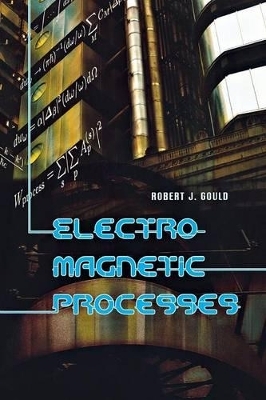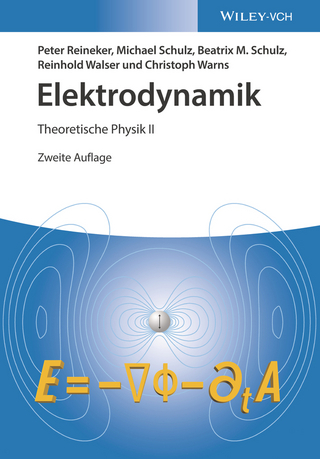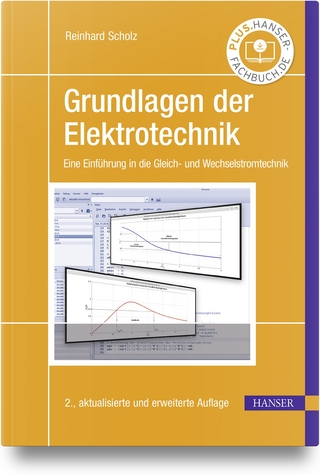
Electromagnetic Processes
Princeton University Press (Verlag)
978-0-691-12444-5 (ISBN)
- Lieferbar (Termin unbekannt)
- Versandkostenfrei innerhalb Deutschlands
- Auch auf Rechnung
- Verfügbarkeit in der Filiale vor Ort prüfen
- Artikel merken
This book provides an understanding of the theoretical foundations for the calculation of electromagnetic processes. Photon production processes are particularly important in astrophysics, since almost all of our knowledge of distant astronomical objects comes from the detection of radiation from these sources. Further, the conditions therein are extremely varied and a wide variety of naturally occurring electromagnetic phenomena can be described by limiting forms of the basic theory. The first chapter reviews some basic principles that are the underpinnings for a general description of electromagnetic phenomena, such as special relativity and, especially, relativistic covariance. Classical and quantum electrodynamics (QED) are then formulated in the next two chapters, followed by applications to three basic processes (Coulomb scattering, Compton scattering, and bremsstrahlung). These processes are related to other phenomena, such as pair production, and the comparisons are discussed. A unique feature of the book is its thorough discussion of the nonrelativistic limit of QED, which is simpler than the relativistic theory in its formulation and applications.
The methods of the relativistic theory are introduced and applied through the use of notions of covariance, to provide a shorter path to the more general theory. The book will be useful for graduate students working in astrophysics and in certain areas of particle physics.
Robert J. Gould is Research Professor of Physics at the University of California, San Diego. His research focuses on atomic, nuclear, and particle processes; statistical mechanics; and applications of astrophysics.
Preface ix Chapter 1. Some Fundamental Principles 1.1 Units and Characteristic Lengths, Times, Energies, Etc. 1.2 Relativistic Covariance and Relativistic Invariants 5 1.2.1 Spacetime Transformation 5 1.2.2 Other Four-Vectors and Tensors-Covariance 8 1.2.3 Some Useful and Important Invariants 10 1.2.4 Covariant Mechanics and Electrodynamics 13 1.3 Kinematic Effects 15 1.3.1 Threshold Energies in Non-Relativistic and Relativistic Processes 15 1.3.2 Transformations of Angular Distributions 17 1.4 Binary Collision Rates 18 1.5 Phase-Space Factors 21 1.5.1 Introduction 21 1.5.2 Simple Examples 23 1.5.3 General Theorems-Formulation 26 1.5.4 General Formulas-Evaluation of Multiple Integrals 28 1.5.5 One-Particle Distributions 32 1.5.6 Invariant Phase Space 34 Chapter 2. Classical Electrodynamics 37 2.1 Retarded Potentials 37 2.1.1 Fields, Potentials, and Gauges 37 2.1.2 Retarded Potentials in the Lorentz Gauge 39 2.2 Multipole Expansion of the Radiation Field 41 2.2.1 Vector Potential and Retardation Expansion 41 2.2.2 Multipole Radiated Power 43 2.3 Fourier Spectra 46 2.4 Fields of a Charge in Relativistic Motion 49 2.4.1 Lienard-Wiechert Potentials 49 2.4.2 Charge in Uniform Motion 51 2.4.3 Fields of an Accelerated Charge 53 2.5 Radiation from a Relativistic Charge 54 2.6 Radiation Reaction 57 2.6.1 Non-Relativistic Limit 57 2.6.2 Relativistic Theory: Lorentz-Dirac Equation 60 2.7 Soft-Photon Emission 61 2.7.1 Multipole Formulation 61 2.7.2 Dipole Formula 62 2.7.3 Emission from Relativistic Particles 63 2.8 Weizsacker-Williams Method 65 2.8.1 Fields of a Moving Charge 66 2.8.2 Equivalent Photon Fluxes 68 2.9 Absorption and Stimulated Emission 70 2.9.1 Relation to Spontaneous Emission 71 2.9.2 General Multiphoton Formula 72 2.9.3 Stimulated Scattering 73 Chapter 3. Quantum Electrodynamics 75 3.1 Brief Historical Sketch 76 3.2 Relationship with Classical Electrodynamics 78 3.3 Non-Relativistic Formulation 80 3.3.1 Introductory Remarks 80 3.3.2 Classical Interaction Hamiltonian 80 3.3.3 Quantum-Mechanical Interaction Hamiltonian 83 3.3.4 Perturbation Theory 84 3.3.5 Processes, Vertices, and Diagrams 88 3.4 Relativistic Theory 94 3.4.1 Modifications of the Non-Covariant Formulation 94 3.4.2 Photon Interactions with Charges without Spin 97 3.4.3 Spin- 1 2Interactions 103 3.4.4 Invariant Transition Rate 107 3.5 Soft-Photon Emission 109 3.5.1 Non-Relativistic Limit 109 3.5.2 Emission from Spin Transitions 113 3.5.3 Relativistic Particles without Spin 116 3.5.4 Relativistic Spin- 1 2Particles 119 3.6 Special Features of Electromagnetic Processes 123 3.6.1 "Order" of a Process 123 3.6.2 Radiative Corrections and Renormalization 127 3.6.3 Kinematic Invariants 130 3.6.4 Crossing Symmetry 132 Chapter 4. Elastic Scattering of Charged Particles 135 4.1 Classical Coulomb Scattering 135 4.1.1 Small-Angle Scattering 135 4.1.2 General Case 138 4.1.3 Two-Body Problem-Relative Motion 139 4.1.4 Validity of the Classical Limit 141 4.2 Non-Relativistic Born Approximation and Exact Treatment 142 4.2.1 Perturbation-Theory Formulation 142 4.2.2 Sketch of Exact Theory 145 4.2.3 Two-Body Problem 148 4.2.4 Scattering of Identical Particles 150 4.2.5 Validity of the Born Approximation 154 4.3 Scattering of Relativistic Particles of Zero Spin 156 4.3.1 Coulomb Scattering 156 4.3.2 Scattering of Two Distinguishable Charges 158 4.3.3 Two Identical Charges 162 4.3.4 Scattering of Charged Antiparticles 163 4.4 Scattering of Relativistic Spin- 1 2Particles 166 4.4.1 Spin Sums, Projection Operators, and Trace Theorems 166 4.4.2 Coulomb Scattering 170 4.4.3 Moller and Bhabha Scattering 171 Chapter 5. Compton Scattering 177 5.1 Classical Limit 177 5.1.1 Kinematics of the Scattering 177 5.1.2 Derivation of the Thomson Cross Section 178 5.1.3 Validity of the Classical Limit 181 5.2 Quantum-Mechanical Derivation: Non-Relativistic Limit 182 5.2.1 Interactions and Diagrams 182 5.2.2 Calculation of the Cross Section 184 5.3 Scattering by a Magnetic Moment 186 5.4 Relativistic Spin-0 Case 188 5.5 Relativistic Spin- 1 2Problem: Klein-Nishina Formula 191 5.5.1 Formulation 191 5.5.2 Evaluation of the Cross Section 193 5.5.3 Invariant Forms 194 5.5.4 Limiting Forms and Comparisons 195 5.6 Relationship to Pair Annihilation and Production 197 5.7 Double Compton Scattering 199 5.7.1 Non-Relativistic Case. Soft-Photon Limit 199 5.7.2 Non-Relativistic Case. Arbitrary Energy 202 5.7.3 Extreme Relativistic Limit 207 Chapter 6. Bremsstrahlung 211 6.1 Classical Limit 211 6.1.1 Soft-Photon Limit 211 6.1.2 General Case: Definition of the Gaunt Factor 214 6.2 Non-Relativistic Born Limit 217 6.2.1 General Formulation for Single-Particle Bremsstrahlung 217 6.2.2 Coulomb (and Screened-Coulomb) Bremsstrahlung 222 6.2.3 Born Correction: Sommerfeld-Elwert Factor 223 6.2.4 Electron-Positron Bremsstrahlung 226 6.3 Electron-Electron Bremsstrahlung. Non-Relativistic 228 6.3.1 Direct Born Amplitude 228 6.3.2 Photon-Emission Probability (without Exchange) 232 6.3.3 Cross Section (with Exchange) 234 6.4 Intermediate Energies 236 6.4.1 General Result. Gaunt Factor 236 6.4.2 Soft-Photon Limit 239 6.5 Relativistic Coulomb Bremsstrahlung 240 6.5.1 Spin-0 Problem 241 6.5.2 Spin- 1 2: Bethe-Heitler Formula 244 6.5.3 Relativistic Electron-Electron Bremsstrahlung 248 6.5.4 Weizsacker-Williams Method 251 6.6 Electron-Atom Bremsstrahlung 254 6.6.1 Low Energies 254 6.6.2 Born Limit-Non-Relativistic 256 6.6.3 Intermediate Energies-Non-Relativistic 257 6.6.4 Relativistic Energies-Formulation 259 6.6.5 Relativistic Energies-Results and Discussion 264 Index 269
| Erscheint lt. Verlag | 11.12.2005 |
|---|---|
| Reihe/Serie | Princeton Series in Astrophysics |
| Zusatzinfo | 2 halftones. 30 line illus. |
| Verlagsort | New Jersey |
| Sprache | englisch |
| Maße | 152 x 235 mm |
| Gewicht | 425 g |
| Themenwelt | Naturwissenschaften ► Physik / Astronomie ► Elektrodynamik |
| ISBN-10 | 0-691-12444-2 / 0691124442 |
| ISBN-13 | 978-0-691-12444-5 / 9780691124445 |
| Zustand | Neuware |
| Informationen gemäß Produktsicherheitsverordnung (GPSR) | |
| Haben Sie eine Frage zum Produkt? |
aus dem Bereich


